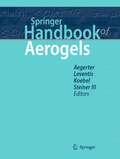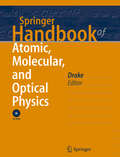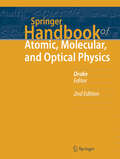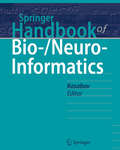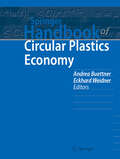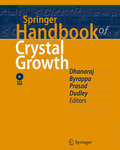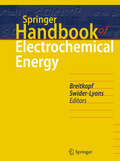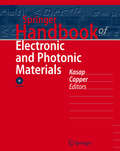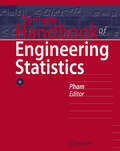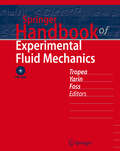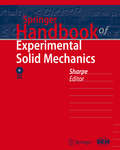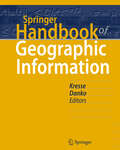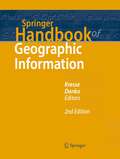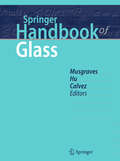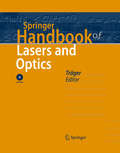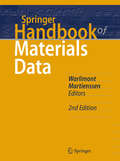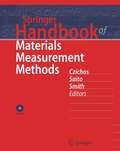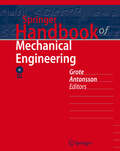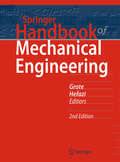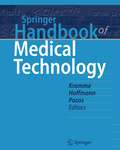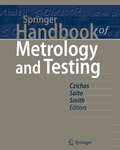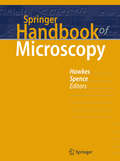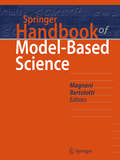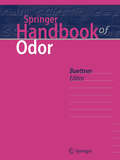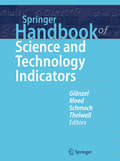- Table View
- List View
Springer Handbook of Aerogels (Springer Handbooks)
by Nicholas Leventis Michel A. Aegerter Matthias Koebel Stephen A. SteinerThis indispensable handbook provides comprehensive coverage of the current state-of-the-art in inorganic, organic, and composite aerogels – from synthesis and characterization to cutting-edge applications and their potential market impact. Built upon Springer’s successful Aerogels Handbook published in 2011, this handbook features extensive revisions and timely updates, reflecting the changes in this fast-growing field. Aerogels are the lightest solids known to man. Up to 1000 times lighter than glass and with a density only four times that of air, they possess extraordinarily high thermal, electrical, and acoustic insulation properties, and boast numerous entries in Guinness World Records. Originally based on silica, R&D efforts have extended this class of materials to incorporate non-silicate inorganic oxides, natural and synthetic organic polymers, carbon, metal, and ceramic materials. Composite systems involving polymer-crosslinked aerogels and interpenetrating hybrid networks have been developed and exhibit remarkable mechanical strength and flexibility. Even more exotic aerogels based on clays, chalcogenides, phosphides, quantum dots, and biopolymers such as chitosan are opening new applications for the construction, transportation, energy, defense and healthcare industries. Applications in electronics, chemistry, mechanics, engineering, energy production and storage, sensors, medicine, nanotechnology, military and aerospace, oil and gas recovery, thermal insulation, and household uses are being developed.Readers of this fully updated and expanded edition will find an exhaustive source for all aerogel materials known today, their fabrication, upscaling aspects, physical and chemical properties, and the most recent advances towards applications and commercial use. This key reference is essential reading for a combined audience of graduate students, academic researchers, and industry professionals.
Springer Handbook of Atomic, Molecular, and Optical Physics
by Gordon W. DrakeComprises a comprehensive reference source that unifies the entire fields of atomic molecular and optical (AMO) physics, assembling the principal ideas, techniques and results of the field. 92 chapters written by about 120 authors present the principal ideas, techniques and results of the field, together with a guide to the primary research literature (carefully edited to ensure a uniform coverage and style, with extensive cross-references). Along with a summary of key ideas, techniques, and results, many chapters offer diagrams of apparatus, graphs, and tables of data. From atomic spectroscopy to applications in comets, one finds contributions from over 100 authors, all leaders in their respective disciplines. Substantially updated and expanded since the original 1996 edition, it now contains several entirely new chapters covering current areas of great research interest that barely existed in 1996, such as Bose-Einstein condensation, quantum information, and cosmological variations of the fundamental constants. A fully-searchable CD- ROM version of the contents accompanies the handbook.
Springer Handbook of Atomic, Molecular, and Optical Physics (Springer Handbooks)
by Gordon W. F. DrakeComprises a comprehensive reference source that unifies the entire fields of atomic molecular and optical (AMO) physics, assembling the principal ideas, techniques and results of the field. 92 chapters written by about 120 authors present the principal ideas, techniques and results of the field, together with a guide to the primary research literature (carefully edited to ensure a uniform coverage and style, with extensive cross-references). Along with a summary of key ideas, techniques, and results, many chapters offer diagrams of apparatus, graphs, and tables of data. From atomic spectroscopy to applications in comets, one finds contributions from over 100 authors, all leaders in their respective disciplines. Substantially updated and expanded since the original 1996 edition, it now contains several entirely new chapters covering current areas of great research interest that barely existed in 1996, such as Bose-Einstein condensation, quantum information, and cosmological variations of the fundamental constants. A fully-searchable CD- ROM version of the contents accompanies the handbook.
Springer Handbook of Bio-/Neuroinformatics
by Nikola KasabovThe Springer Handbook of Bio-/Neuro-Informatics is the first published book in one volume that explains together the basics and the state-of-the-art of two major science disciplines in their interaction and mutual relationship, namely: information sciences, bioinformatics and neuroinformatics. Bioinformatics is the area of science which is concerned with the information processes in biology and the development and applications of methods, tools and systems for storing and processing of biological information thus facilitating new knowledge discovery. Neuroinformatics is the area of science which is concerned with the information processes in biology and the development and applications of methods, tools and systems for storing and processing of biological information thus facilitating new knowledge discovery. The text contains 62 chapters organized in 12 parts, 6 of them covering topics from information science and bioinformatics, and 6 cover topics from information science and neuroinformatics. Each chapter consists of three main sections: introduction to the subject area, presentation of methods and advanced and future developments. The Springer Handbook of Bio-/Neuroinformatics can be used as both a textbook and as a reference for postgraduate study and advanced research in these areas. The target audience includes students, scientists, and practitioners from the areas of information, biological and neurosciences. With Forewords by Shun-ichi Amari of the Brain Science Institute, RIKEN, Saitama and Karlheinz Meier of the University of Heidelberg, Kirchhoff-Institute of Physics and Co-Director of the Human Brain Project.
Springer Handbook of Circular Plastics Economy (Springer Handbooks)
by Andrea Buettner Eckhard WeidnerThis Springer Handbook assembles the existing knowledge concerning plastic materials and identifies obstacles and objectives of innovations and technologies that will bring human society closer to the goal of a fully circular economy of plastic materials. Consumers profit everyday from the versatile functionalities of plastic materials, but this diversity also brings a range of challenges: recycling may be costly and laborious, and too many plastic products still end up as waste in the environment. The handbook offers a source of information, a knowledge base, and inspiration for those aiming to create an economy that paves the road for future generations. The editorial board and invited authors represent international key figures from a broad range of disciplines, including chemistry, engineering, material sciences, logistics, data and information sciences, systems engineering, economy and sustainability as well as disciplines related to culture, art, and design. With its diversity, the book aims to fulfil the huge demand for information on novel technologies and legal approaches in politics, industry and society. Key topics include: Development of biodegradable plastics Advanced recycling strategies Design for recyclability Legal and economic perspectives Role of startups and innovative technologies Novel business models and business strategies By allowing the reader to learn and apply the measures needed for the implementation of a Circular Plastics Economy, the hanbook will be of particular interest to innovators, decision-makers, planners, designers, producers in industry, politics, and society as well as consumers, students, teachers, communicators, journalists, and cultural workers.
Springer Handbook of Crystal Growth
by Vishwanath Prasad Michael Dudley Govindhan Dhanaraj Kullaiah ByrappaThe Springer Handbook of Crystal Growth brings together the science and technology of growing crystals, defect characterization and techniques, and understanding the defect formation including defects modelling. This unique effort will provide users with fundamental understanding of crystal growth and defects with the latest instrumentation/ techniques available both for crystal fabrication and defects. Understanding in this rapidly advancing field deals with three main areas: Crystal growth and defect formation, growth methods, and various techniques used in characterization.
Springer Handbook of Electrochemical Energy
by Cornelia Breitkopf Karen Swider-LyonsThe Springer Handbook of Electrochemistry is a comprehensive knowledge source for professionals, graduate students and scientists. It pays particular attention to applications in industrial and energy applications and emphasizes the relevance of experimental work. The book consists of nine parts the book comprises topics like fundamental experimentation techniques, electrochemistry as interdisciplinary topic, theory and modeling tools, thermodynamic aspects, transport phenomena, spectroscopy and microprobes, technical electrochemistry and important applications.
Springer Handbook of Electronic and Photonic Materials
by Peter Capper C. Koughia Safa KasapContributions from well known and respected researchers throughout the world Thorough coverage of electronic and opto-electronic materials that today's electrical engineers, material scientists and physicists need Interdisciplinary approach encompasses research in disciplines such as materials science, electrical engineering, chemical engineering, mechanical engineering, physics and chemistry
Springer Handbook of Engineering Statistics
by Hoang PhamIn today's global and highly competitive environment, continuous improvement in the processes and products of any field of engineering is essential for survival. This book gathers together the full range of statistical techniques required by engineers from all fields. It will assist them to gain sensible statistical feedback on how their processes or products are functioning and to give them realistic predictions of how these could be improved. The handbook will be essential reading for all engineers and engineering-connected managers who are serious about keeping their methods and products at the cutting edge of quality and competitiveness.
Springer Handbook of Experimental Fluid Mechanics
by John F. Foss Alexander L. Yarin Cameron TropeaThis key text is a major reference work - a totally authoritative handbook on a major current topic. It consolidates state-of-the-art information from the large number of disciplines used in Experimental Fluid Mechanics into a readable desk reference book. It comprises four parts: Experiments in Fluid Mechanics, Measurement of Primary Quantities, Specific Experimental Approaches, and Analyses and Post-Processing of Data. The book has been prepared for physicists and engineers in research and development in universities, in industry and in other research institutions. Both experimental methodology and techniques are covered fundamentally and for a wide range of application fields. A generous use of citations directs the reader to additional material on each subject.
Springer Handbook of Experimental Solid Mechanics
by William N. Sharpe Jr.As a reference book, the Springer Handbook provides a comprehensive exposition of the techniques and tools of experimental mechanics. An informative introduction to each topic is provided, which advises the reader on suitable techniques for practical applications. New topics include biological materials, MEMS and NEMS, nanoindentation, digital photomechanics, photoacoustic characterization, and atomic force microscopy in experimental solid mechanics. Written and compiled by internationally renowned experts in the field, this book is a timely, updated reference for both practitioners and researchers in science and engineering.
Springer Handbook of Geographic Information
by Wolfgang Kresse David M. DankoComputer science provides a powerful tool that was virtually unknown three generations ago. Some of the classical fields of knowledge are geodesy (surveying), cartography, and geography. Electronics have revolutionized geodetic methods. Cartography has faced the dominance of the computer that results in simplified cartographic products. All three fields make use of basic components such as the Internet and databases. The Springer Handbook of Geographic Information is organized in three parts, Basics, Geographic Information and Applications. Some parts of the basics belong to the larger field of computer science. However, the reader gets a comprehensive view on geographic information because the topics selected from computer science have a close relation to geographic information. The Springer Handbook of Geographic Information is written for scientists at universities and industry as well as advanced and PhD students.
Springer Handbook of Geographic Information (Springer Handbooks)
by Wolfgang Kresse David DankoThis handbook provides an exhaustive, one-stop reference and a state-of-the-art description of geographic information and its use. This new, substantially updated edition presents a complete and rigorous overview of the fundamentals, methods and applications of the multidisciplinary field of geographic information systems. Designed to be a useful and readable desk reference book, but also prepared in various electronic formats, this title allows fast yet comprehensive review and easy retrieval of essential reliable key information. The Springer Handbook of Geographic Information is divided into three parts. Part A, Basics and Computer Science, provides an overview on the fundamentals, including descriptions of databases and encoding of geographic information. It also covers the underlying mathematical and statistics methods and modeling. A new chapter exemplifies the emerging use and analysis of big data in a geographic context. Part B offers rigorous descriptions of gathering, processing and coding of geographic information in a standardized way to allow interoperable use in a variety of systems; from traditional methods such as geodesy and surveying to state-of-the-art remote sensing and photogrammetry; from cartography to geospatial web services. Discussions on geosemantic interoperability and security of open distributed geospatial information systems complete the comprehensive coverage. The final part describes a wide array of applications in science, industry and society at large, such as agriculture, defense, transportation, energy and utilities, health and human services. The part is enhanced by new chapters on smart cities and building information modeling, as well as a complete overview of the currently available open-source geographic information systems. Using standardized international terminology, in accordance with ISO/TC 211 and INSPIRE, this handbook facilitates collaboration between different disciplines and is a must have for practitioners and new comers in industry and academia.
Springer Handbook of Glass (Springer Handbooks)
by J. David Musgraves Juejun Hu Laurent CalvezThis handbook provides comprehensive treatment of the current state of glass science from the leading experts in the field. Opening with an enlightening contribution on the history of glass, the volume is then divided into eight parts. The first part covers fundamental properties, from the current understanding of the thermodynamics of the amorphous state, kinetics, and linear and nonlinear optical properties through colors, photosensitivity, and chemical durability. The second part provides dedicated chapters on each individual glass type, covering traditional systems like silicates and other oxide systems, as well as novel hybrid amorphous materials and spin glasses. The third part features detailed descriptions of modern characterization techniques for understanding this complex state of matter. The fourth part covers modeling, from first-principles calculations through molecular dynamics simulations, and statistical modeling. The fifth part presents a range of laboratory and industrial glass processing methods. The remaining parts cover a wide and representative range of applications areas from optics and photonics through environment, energy, architecture, and sensing. Written by the leading international experts in the field, the Springer Handbook of Glass represents an invaluable resource for graduate students through academic and industry researchers working in photonics, optoelectronics, materials science, energy, architecture, and more.
Springer Handbook of Lasers and Optics
by Frank TrägerSpringer Handbook of Lasers and Optics gives a complete and up-to-date overview of this area in one consistent book. All chapters are written by leading experts. They are clearly structured with coherent presentation and editing. A CD-ROM is included for easy search. The book is designed for daily use in the office or laboratory and offers descriptive text, data, and references needed for anyone working with lasers and optical instruments. With a foreword by Theodor W. Hänsch, the book will interest optical physicists and optical engineers at universities and in industrial research and development.
Springer Handbook of Materials Data
by Hans Warlimont Werner MartienssenThe second edition of this well-received handbook is the most concise yet comprehensive compilation of materials data. The chapters provide succinct descriptions and summarize essential and reliable data for various types of materials. The information is amply illustrated with 900 tables and 1050 figures selected primarily from well-established data collections, such as Landolt-Börnstein, which is now part of the SpringerMaterials database. The new edition of the Springer Handbook of Materials Data starts by presenting the latest CODATA recommended values of the fundamental physical constants and provides comprehensive tables of the physical and physicochemical properties of the elements. 25 chapters collect and summarize the most frequently used data and relationships for numerous metals, nonmetallic materials, functional materials and selected special structures such as liquid crystals and nanostructured materials. Along with careful updates to the content and the inclusion of timely and extensive references, this second edition includes new chapters on polymers, materials for solid catalysts and low-dimensional semiconductors.This handbook is an authoritative reference resource for engineers, scientists and students engaged in the vast field of materials science.
Springer Handbook of Materials Measurement Methods
by Tetsuya Saito Leslie E. Smith Horst CzichosThis Handbook compiles advanced methods for materials measurement and characterization from the macroscopic to the nano-scale. Materials professionals need not only handbooks of materials data but clear guidelines and standards for how to measure the full spectrum of materials characteristics of new materials ans systems. Since materials science forms a bridge between the more traditonal fields of physics, engineering, and chemistry, unifying the varying perspectives and covering the full gamut of properties also serves a useful purpose. This handbook is the first dedicated to these practical and important considerations.
Springer Handbook of Mechanical Engineering
by Karl-Heinrich Grote Erik K. AntonssonThis resource covers all areas of interest for the practicing engineer as well as for the student at various levels and educational institutions. It features the work of authors from all over the world who have contributed their expertise and support the globally working engineer in finding a solution for today's mechanical engineering problems. Each subject is discussed in detail and supported by numerous figures and tables.
Springer Handbook of Mechanical Engineering (Springer Handbooks)
by Karl-Heinrich Grote Hamid HefaziThis resource covers all areas of interest for the practicing engineer as well as for the student at various levels and educational institutions. It features the work of authors from all over the world who have contributed their expertise and support the globally working engineer in finding a solution for today‘s mechanical engineering problems. Each subject is discussed in detail and supported by numerous figures and tables.
Springer Handbook of Medical Technology
by Robert Steven Pozos Klaus-Peter Hoffmann Rüdiger KrammeThis concise, user-oriented and up-to-date desk reference offers a broad introduction to the fascinating world of medical technology, fully considering today's progress and further development in all relevant fields. The Springer Handbook of Medical Technology is a systemized and well-structured guideline which distinguishes itself through simplification and condensation of complex facts. This book is an indispensable resource for professionals working directly or indirectly with medical systems and appliances every day. It is also meant for graduate and post graduate students in hospital management, medical engineering, and medical physics.
Springer Handbook of Metrology and Testing
by Tetsuya Saito Leslie E. Smith Horst CzichosThis Springer Handbook of Metrology and Testing presents the principles of Metrology - the science of measurement - and the methods and techniques of Testing - determining the characteristics of a given product - as they apply to chemical and microstructural analysis, and to the measurement and testing of materials properties and performance, including modelling and simulation. The principal motivation for this Handbook stems from the increasing demands of technology for measurement results that can be used globally. Measurements within a local laboratory or manufacturing facility must be able to be reproduced accurately anywhere in the world. The book integrates knowledge from basic sciences and engineering disciplines, compiled by experts from internationally known metrology and testing institutions, and academe, as well as from industry, and conformity-assessment and accreditation bodies. The Commission of the European Union has expressed this as there is no science without measurements, no quality without testing, and no global markets without standards.
Springer Handbook of Microscopy (Springer Handbooks)
by Peter W. Hawkes John C. H. SpenceThis book features reviews by leading experts on the methods and applications of modern forms of microscopy. The recent awards of Nobel Prizes awarded for super-resolution optical microscopy and cryo-electron microscopy have demonstrated the rich scientific opportunities for research in novel microscopies. Earlier Nobel Prizes for electron microscopy (the instrument itself and applications to biology), scanning probe microscopy and holography are a reminder of the central role of microscopy in modern science, from the study of nanostructures in materials science, physics and chemistry to structural biology.Separate chapters are devoted to confocal, fluorescent and related novel optical microscopies, coherent diffractive imaging, scanning probe microscopy, transmission electron microscopy in all its modes from aberration corrected and analytical to in-situ and time-resolved, low energy electron microscopy, photoelectron microscopy, cryo-electron microscopy in biology, and also ion microscopy. In addition to serving as an essential reference for researchers and teachers in the fields such as materials science, condensed matter physics, solid-state chemistry, structural biology and the molecular sciences generally, the Springer Handbook of Microscopy is a unified, coherent and pedagogically attractive text for advanced students who need an authoritative yet accessible guide to the science and practice of microscopy.
Springer Handbook of Model-Based Science
by Tommaso Bertolotti Lorenzo MagnaniThis handbook offers the first comprehensive reference guide to the interdisciplinary field of model-based reasoning. It highlights the role of models as mediators between theory and experimentation, and as educational devices, as well as their relevance in testing hypotheses and explanatory functions. The Springer Handbook merges philosophical, cognitive and epistemological perspectives on models with the more practical needs related to the application of this tool across various disciplines and practices. The result is a unique, reliable source of information that guides readers toward an understanding of different aspects of model-based science, such as the theoretical and cognitive nature of models, as well as their practical and logical aspects. The inferential role of models in hypothetical reasoning, abduction and creativity once they are constructed, adopted, and manipulated for different scientific and technological purposes is also discussed. Written by a group of internationally renowned experts in philosophy, the history of science, general epistemology, mathematics, cognitive and computer science, physics and life sciences, as well as engineering, architecture, and economics, this Handbook uses numerous diagrams, schemes and other visual representations to promote a better understanding of the concepts. This also makes it highly accessible to an audience of scholars and students with different scientific backgrounds. All in all, the Springer Handbook of Model-Based Science represents the definitive application-oriented reference guide to the interdisciplinary field of model-based reasoning.
Springer Handbook of Odor
by Andrea BuettnerThe Springer Handbook of Odor is the definitive guide to all aspects related to the study of smell and their impact on human life. For the first time, this handbook aligns the senso-chemo-analytical characterization of everyday smells encountered by mankind, with the elucidation of perceptual, hedonic, behavioral and physiological responses of humans to such odors. From birth onwards we learn to interact with our environment using our sense of smell. Moreover, evolutionary processes have engendered a multi-faceted communication that is supported - even dominated - by olfaction. This compilation examines the responses of humans to odors at different stages of life, thereby building a foundation for a widely overseen area of research with broader ramifications for human life. The expert international authors and editor align aspects, concepts, methodologies and perspectives from a broad range of different disciplines related to the science of smell. These include chemistry, physiology, psychology, material sciences, technology but also disciplines related to linguistics, culture, art and design. This handbook, edited by an internationally renowned aroma scientist with the support of an outstanding team of over 60 authors, is an authoritative reference for researchers in the field of odors both in academia and in industry and is also a useful reference for newcomers to the area.
Springer Handbook of Science and Technology Indicators (Springer Handbooks)
by Ulrich Schmoch Henk F. Moed Mike Thelwall Wolfgang GlänzelThis handbook presents the state of the art of quantitative methods and models to understand and assess the science and technology system. Focusing on various aspects of the development and application of indicators derived from data on scholarly publications, patents and electronic communications, the individual chapters, written by leading experts, discuss theoretical and methodological issues, illustrate applications, highlight their policy context and relevance, and point to future research directions.A substantial portion of the book is dedicated to detailed descriptions and analyses of data sources, presenting both traditional and advanced approaches. It addresses the main bibliographic metrics and indexes, such as the journal impact factor and the h-index, as well as altmetric and webometric indicators and science mapping techniques on different levels of aggregation and in the context of their value for the assessment of research performance as well as their impact on research policy and society. It also presents and critically discusses various national research evaluation systems.Complementing the sections reflecting on the science system, the technology section includes multiple chapters that explain different aspects of patent statistics, patent classification and database search methods to retrieve patent-related information. In addition, it examines the relevance of trademarks and standards as additional technological indicators.The Springer Handbook of Science and Technology Indicators is an invaluable resource for practitioners, scientists and policy makers wanting a systematic and thorough analysis of the potential and limitations of the various approaches to assess research and research performance.
